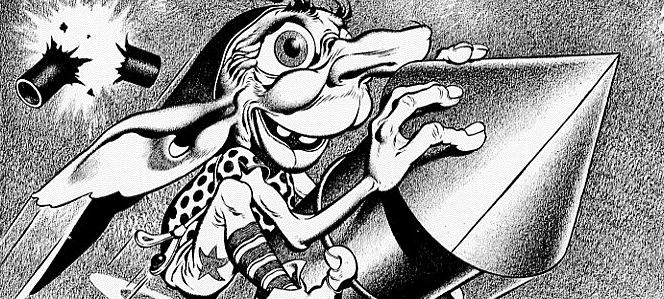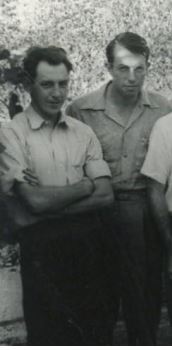Comments
John Stewart “Jack” Williamson (1908-2006) should be on anyone’s short list for Most Science-Fictional Life. He was born in Arizona before it became a state and moved to New Mexico via covered wagon. A casual encounter with Amazing Stories changed his life and he sold a story to Hugo Gernsback before he was old enough to vote. He coined the term “genetic engineering” two years before DNA’s structure was discovered. (And also coined “terraformed” in 1942, six decades later winning the John W. Campbell Award for a novel intriguingly named Terraforming Earth.) At the age of 56 he completed a Ph.D. with a dissertation on H. G. Wells and was a force in the expansion of teaching science fiction at the college level. As a professor he wrote more sf novels than he had in his first 40 years as a freelancer. He won both the Hugo and Nebula Awards for a story published in the year 2000, when he was a mere 92.
Seetee Ship’s odd title is explained in an excerpt from the “Spaceman’s Handbook” used as a foreword:
SEETEE (from CONTRATERRENE, CT). An inverted type of matter… Seetee atoms are inside out, electrically, with negative nuclei and positive atoms.
Or a somewhat garbled version of what we today call antimatter. Contraterrene seems to have popped into use in 1940 and John W. Campbell looked for an author who could exploit the concept. Williamson had already pitched a series on making the asteroids habitable for miners. They agreed to mesh the two ideas. Three stories in 1942 and 1943 and three more in 1949 emerged, all written under the pseudonym Will Stewart, the only time he used that name. Williamson apparently invented “seetee” as a term. Several other writers have used it since, but it’s rare enough that most modern readers would stumble over it.
Sam Moskowitz recorded the unexpected sequel. The usually good-natured Villiers Gerson blasted Seetee Ship in the New York Times Book Review, closing with “It is a pity that the quality of Stewart’s writing is such that that this “space opera” ranks only slightly above that of a comic strip adventure.” No one other than an editor looking to start a high-quality comic strip could read that favorably, but to Williamson’s incredibly good fortune that was exactly the situation of the New York Sunday News. They tracked him down and offered him a strip that would become known as Beyond Mars, based on his Seetee stories. Veteran artist Lee Elias did the art, printed in gorgeous color Sundays from 1952 until the strip was ended in 1955.
Gnome Notes
A second novel, Seetee Shock, was serialized in Astounding in 1949 and published as a book in 1950. It’s a sequel, even though it saw print first. Other Williamson books are listed on Seetee’s pre-title page, presumably to let readers know about the pseudonym. The first book listed is Seetee Shock, and then five others are as by Jack Williamson.
This book starts two pleasant graphical traditions for Gnome. The spine contains a drawing of a space-helmeted gnome riding a rocket-powered book. It’s almost invisible here but would become more prominent on future titles. And the title page has a doodle-like figure of a soaring ship, repeated on the copyright page, that is presumably a speeding seetee ship. Small graphics reflecting the nature of the book pepped up future title pages as well. Reviewers noticed. P. Schuyler Miller, in the November 1951 Astounding, wrote that:
“Seetee Ship,” incidentally, is typographically a much better book than the S&S [Simon & Schuster] volume [Seetee Shock]. The fantasy publishers with lower overhead and probably a smaller margin of profit, are doing a consistently better job in this respect than the big general publishers who take on science-fiction as a sideline.
Kirkus Reviews gave the expected publication date as June 15, 1951.
Reviews
Sam Merwin Jr., Amazing Stories, December 1951
[T]his story is generally swift, fast, sure and at least moderately exciting.
Groff Conklin, Galaxy Science Fiction, November 1951
It’s a good story if you can bear plowing through pages of literary corn-starch.
Contents and original publication
• “Spaceman’s Handbook excerpt” (original to this volume).
• Chapters 1-20 (rewritten from “Collision Orbit,” Astounding Science-Fiction, July 1942; Minus Sign,” Astounding Science-Fiction, November 1942; and “Opposites—React!” Astounding Science-Fiction, January and February 1943).
Bibliographic information
Seetee Ship, by Will Stewart (pseud. of Jack Williamson), 1951, copyright registration 15Jul51, Library of Congress Catalog Card Number not given [retroactively 51-11667], 255 pages, title #15, back panel #15, $2.75. 4000 copies printed. Hardback, black cloth, spine lettered in orange. Jacket design by Edd Cartier. “FIRST EDITION” stated on copyright page. Manufactured in the United States of America. Colonial Press, Printers. David Kyle, Designer. Jacket adds “An Interplanetary Novel.” Back panel: 10 titles. Gnome Press address given as 80 East 11th St., N.Y. 3.
Variants
None known.





